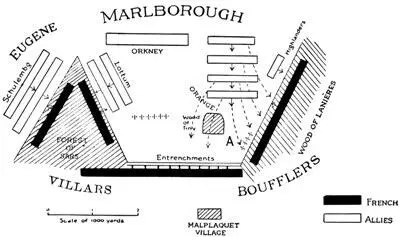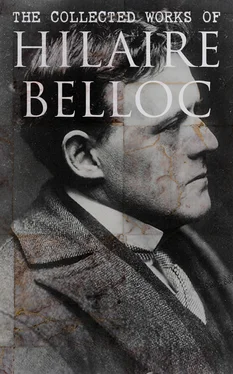It would be the business of the allies to try and force this line, either by carrying the central entrenchments across the gap or by turning the French left flank in the forest of Sars or the French right flank in the wood of Lanière, or by both of these attempts combined; for it must be remembered that the numerical superiority of the allies gave them a choice of action. Should either the stand on the left or that on the right be forced, the French line would be turned and the destruction of the army completed. Should the centre be pierced effectively and in time, the Northern half of the army so severed would certainly be destroyed, for there was no effective line of retreat; the Southern half might or might not escape towards the valley of the Sambre. In either case a decisive victory would destroy the last of the French bodies of defence and would open the way for an almost uninterrupted march upon Paris.
It will be self-evident to the reader that what with Villars’ known methods, his dependence upon his engineers, the tradition of the French service in this respect, the inferior numbers of the French forces, and the glaring necessities of the position, earthworks would be a deciding factor in the result.
Now the value of entrenchment is a matter of time, and before proceeding to a description of the action we must, if we are to understand its result, appreciate how great an advantage was conferred upon the French by the delay in the attack of the allies.
As I have said, it was upon the morning of Monday, September 9th, that the two armies were drawn up facing each other, and there is no apparent reason why the assault should not have been delivered upon that day. Had it been delivered we can hardly doubt that a decisive defeat of the French would have resulted, that the way to Paris would have been thrown open, and that the ruin of the French monarchy would have immediately followed. As it was, no attack was delivered upon that Monday. The whole of Tuesday was allowed to pass without a movement. It was not until the Wednesday morning that the allies moved.
The problem of this delay is one which the historian must anxiously consider, for the answer to it explains the barrenness and political failure associated with the name of Malplaquet. But it is one which the historian will not succeed in answering unless indeed further documents should come to light. All that we now know is that in a council of war held upon the Monday on the side of the allies, it was thought well to wait until all the troops from Tournai should have come up (though these were few in number), and necessary to send 9000 men to hold the bridge across the Haine at St. Ghislain in order to secure retreat in case of disaster. 10
The English historians blame the Dutch, the Dutch the English, and the Austrians and Prussians blame both.
Perhaps there would have been an attack upon the Tuesday at least had not Villars spent all the Monday and all the Monday night in exacting from his men the most unexpected labours in constructing entrenchments of the most formidable character. Marlborough and Eugene, riding out before their lines to judge their chances on the Tuesday, were astonished at the work that had been done in those twenty-four hours. Nine redans, that is, openworks of peculiar strength, stretched across the gap to within about 600 yards of the wood of Lanière, and the remainder of the space was one continuous line of entrenchment. What had been done in the woods could not be judged from such a survey, but it might be guessed, and the forcing of these became a very different problem from what it would have been had an attack been delivered on the Monday. Behind this main line Villars drew up another and yet another series of earthworks; even Malplaquet itself, with the reserve in the rear, was defended, and the work was continued without interruption even throughout the Tuesday night with relays of men.
When at last, upon the Wednesday morning, the allies had arrived at their tardy agreement and determined to force an action, their superiority in numbers, such as it was (and this disputed point must be later discussed), was quite negatived by having to meet fortifications so formidable as to be called, in the exaggerated phrase of a witness, “a citadel.”
One last point must be mentioned before the action itself is described: the open gap across which the centre of the allies must advance to break the French centre and encapture the entrenchments was cut in two by a large copse or small wood, called “The Wood of Tiry.” It was not defended, lying too far in front of the French line, and was of no great consequence save in this: that when the advance of the allies against the French defence should begin, it was bound to canalise and cut off from support for a moment the extreme left of that advance through the channel marked A upon the map over page. As will be seen, the Dutch advanced too early and in too great strength through this narrow gap, and the check they suffered, which was of such effect upon the battle, would not have been nearly so severe had not the little wood cut them off from the support of the centre.
Table of Contents
On the morning of Wednesday, the 11th of September, the allied army was afoot long before dawn, and was ranged in order of battle earlier than four o’clock. But a dense mist covered the ground, and nothing was done until at about half-past seven this lifted and enabled the artillery of the opposing forces to estimate the range and to open fire. In order to understand what was to follow, the reader may, so to speak, utilise this empty period of the early morning before the action joined, to grasp the respective positions of the two hosts.

The Elements of the Action of Malplaquet, September 11th, 1709.
The nature of the terrain has already been described. The plan upon the part of the allies would naturally consist in an attempt to force both woods which covered the French flank, and, while the pressure upon these was at its strongest, the entrenched and fortified centre. Of course, if either of the woods was forced before the French centre should break, there would be no need to continue the central attack, for one or other of the French flanks would then be turned. But the woods were so well garnished by this time, and so strongly lined with fallen tree-trunks and such entrenchments as the undergrowth permitted, that it seemed to both Eugene and Marlborough more probable that the centre should be forced than that either of the two flanks should first be turned, and the general plan of the battle depended rather upon the holding and heavy engagement of the forces in the two woods to the north and south than in any hope to clear them out, and the final success was expected rather to take the form of piercing the central line while the flanks were thus held and engaged. The barren issue of the engagement led the commanders of the allies to excuse themselves, of course, and the peculiar ill-success of their left against the French right, which we shall detail in a moment, gave rise to the thesis that only a “feint” was intended in that quarter. The thesis may readily be dismissed. The left was intended to do serious work quite as much as the right. The theory that it was intended to “feint” was only produced after the action, and in order to explain its incomplete results. 11
Upon the French side the plan was purely defensive, as their inferior numbers and their reliance upon earthworks both necessitated and proved. It was Villars’ plan to hold every part of his line with a force proportionate to its strength; to furnish the woods a little more heavily than the entrenchments of the open gap, but everywhere to rely upon the steadiness of his infantry and their artificial protections in the repelling of the assault. His cavalry he drew up behind this long line of infantry defence, prepared, as has already been said, to charge through gaps whenever such action on their part might seem effective.
Читать дальше













